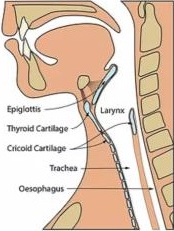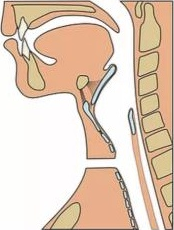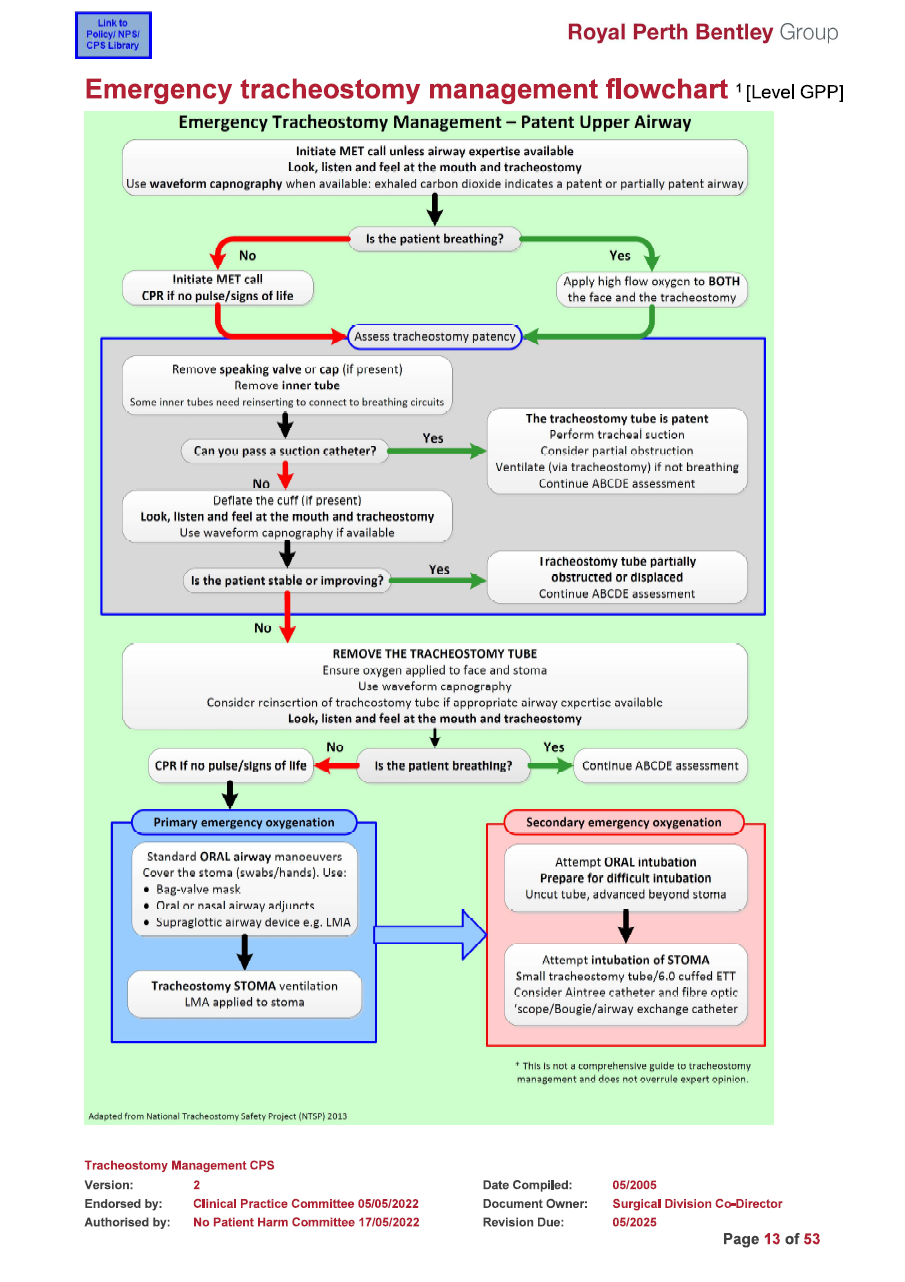
Tracheostomy
- A stoma is created through the neck to the trachea to form an airway below the larynx. The larynx remains intact.
- Tracheostomy patients can breathe through their stoma and potentially their mouth / nose to some extent.
- A tracheostomy tube +/- inner tube may be present.
Laryngectomy
Patients with a laryngectomy cannot be oxygenated, ventilated or intubated via the mouth.
- A stoma is created through the neck to the trachea to form an airway, however the larynx is completely removed. The trachea is only connected to the neck and stoma. Airflow from the mouth and nose into the trachea is impossible.
- Usually, a tube will not be in situ. Other devices such as laryngeal buttons, heat-moisture exchangers (HME) or tracheo-oesophageal puncture (‘TOP’) speaking valves may be present.
Read more in the Medical Library article.
Patients with tracheostomy or laryngectomy who are showing signs of:
- Change in level of consciousness
- Increased work of breathing
- Oxygen desaturation
- Cyanosis
- Nil or reduced air flow out of the tracheostomy tube
- Decreased, nil or gurgling breath sounds
- Unusual vocal, upper or lower airway sounds such as stridor, wheeze or louder than usual crying which indicates exhaled air is passing through the upper airway rather than the tracheostomy tube
- High inspiratory airway pressure (or low tidal volume if the patient is mechanically ventilated)
- Unable to pass the suction catheter or inner cannula
- The default route of oxygenation and ventilation in all patients should be the stoma.
- It may be hard to establish whether the patient has a laryngectomy or tracheostomy. Where uncertain, providing oxygen via both routes is advocated.
- Patients and carers will frequently be familiar with the management of tracheostomy / laryngectomy emergencies. Consider their advice and follow any action plans that may be present.
- Discuss with the caregiver about reattaching any external devices (e.g. Swedish nose, speaking valve) that were removed prior to starting the procedure; these may stay disconnected in case the patient requires suctioning during ambulance transport.
Suction
Oxygenation
- Oxygen via the stoma is the priority as it is appropriate for both laryngectomy and tracheostomy patients.
- If two sources of oxygen are available, a second mask should be added to the patient’s face as some tracheostomy patients may benefit from oxygenation via a partially patent upper airway, especially if their tracheostomy is totally blocked.
Apnoeic / cardiac arrest
- Ventilation / intubation should be attempted via the stoma.
- When ventilating through the stoma, assess for significant air leak through the mouth. If this is present the upper airway may be patent to some extent. BVM ventilation via the stoma is unlikely to be successful. Paramedics should attempt to cover the stoma with an occlusive dressing to achieve an airtight seal and manage the patient via the upper airway.
- Ensure monitoring with ETCO2 for all ventilation
- As per First Aid guidelines
- As per Primary Care guidelines
- As per Intermediate Care guidelines
- As per Advanced Care guidelines
Patients who are critically ill or have comorbidities are more at risk and complications become more likely the longer the tube is kept in situ. Complications that can occur with a tracheostomy include:
- Partial or complete airway obstruction due to blockage
- Tracheostomy tube dislodgement or tracheostomy in a false passage
- Tracheal damage or erosion
- Tracheal stenosis
- Formation of stomal or tracheal granulation tissue
- Persistent cuff leak
- Faulty oxygen source or ventilation device
- Ineffective humidification
- Infection
- Aspiration

Normal airway

Tracheostomy

Laryngectomy
| Settings | |
|---|---|
| Extended Care: | |
| Colour assist: | |
Document Control
Clinical Resources Website
St John Ambulance Western Australia Ltd (ABN 55 028 468 715) (St John WA) operates ambulance and other pre-hospital clinical services. St John WA’s Clinical Resources, including its Clinical Practice Guidelines (Clinical Resources), are intended for use by credentialed St John WA staff and volunteers when providing clinical care to patients for or on behalf of St John WA, within the St John WA Clinical Governance Framework, and only to the extent of the clinician’s authority to practice.
Other users – Terms of Use
The content of the St John WA Clinical Resources is provided for information purposes only and is not intended to serve as health, medical or treatment advice. Any user of this website agrees to be bound by these Terms of Use in their use of the Clinical Resources.
St John WA does not represent or warrant (whether express, implied, statutory, or otherwise) that the content of the Clinical Resources is accurate, reliable, up-to-date, complete or that the information contained is suitable for your needs or for any particular purpose. You are responsible for assessing whether the information is accurate, reliable, up-to-date, authentic, relevant, or complete and where appropriate, seek independent professional advice.
St John WA expressly prohibits use of these Clinical Resources to guide clinical care of patients by organisations external to St John WA, except where these organisations have been directly engaged by St John WA to provide services. Any use of the Clinical Resources, with St John WA approval, must attribute St John WA as the creator of the Clinical Resources and include the copyright notice and (where reasonably practicable) provide a URL/hyperlink to the St John WA Clinical Resources website.
No permission or licence is granted to reproduce, make commercial use of, adapt, modify or create derivative works from these Clinical Resources. For permissions beyond the scope of these Terms of Use, including a commercial licence, please contact medservices@stjohnambulance.com.au
Where links are provided to resources on external websites, St John WA:
- Gives no assurances about the quality, accuracy or relevance of material on any linked site;
- Accepts no legal responsibility regarding the accuracy and reliability of external material; and
- Does not endorse any material, associated organisation, product or service on other sites.
Your use of any external website is governed by the terms of that website, including any authorisation, requirement or licence for use of the material on that website.
To the maximum extent permitted by law, St John WA excludes liability (including liability in negligence) for any direct, special, indirect, incidental, consequential, punitive, exemplary or other loss, cost, damage or expense arising out of, or in connection with, use or reliance on the Clinical Resources (including without limitation any interference with or damage to a user’s computer, device, software or data occurring in connection with such use).
Cookies
Please read this cookie policy carefully before using Clinical Resources from St John WA.
The cookies used on this site are small and completely anonymous pieces of information and are stored on your computer or mobile device. The data that the cookies contain identify your user preferences (such as your preferred text size, scope / skill level preference and Colour Assist mode, among other user settings) so that they can be recalled the next time that you visit a page within Clinical Resources. These cookies are necessary to offer you the best and most efficient possible experience when accessing and navigating through our website and using its features. These cookies do not collect or send analytical information back to St John WA.
Clinical Resources does integrate with Google Analytics and any cookies associated with this service enable us (and third-party services) to collect aggregated data for statistical purposes on how our visitors use this website. These cookies do not contain personal information such as names and email addresses and are used to help us improve your user experience of the website.
If you want to restrict or block the cookies that are set by our website, you can do so through your browser setting. Alternatively, you can visit www.internetcookies.com, which contains comprehensive information on how to do this on a wide variety of browsers and devices. You will find general information about cookies and details on how to delete cookies from your device. If you have any questions about this policy or our use of cookies, please contact us.
